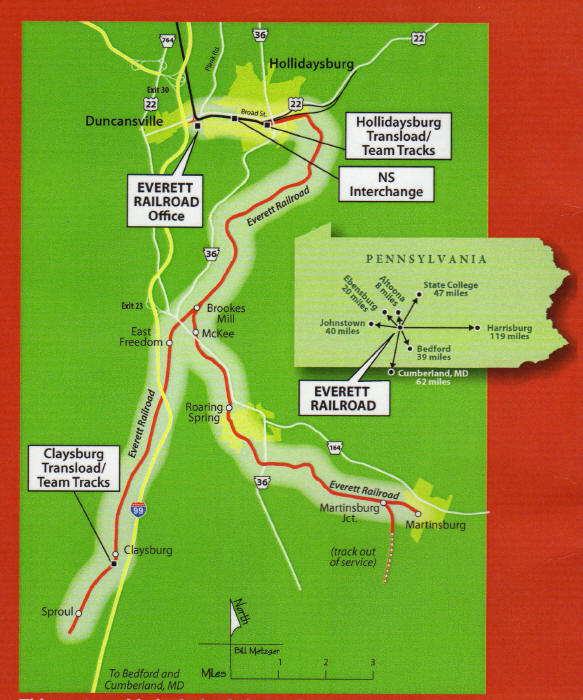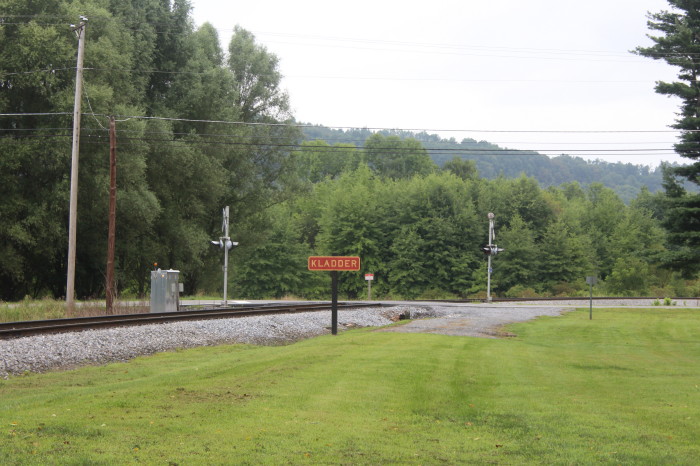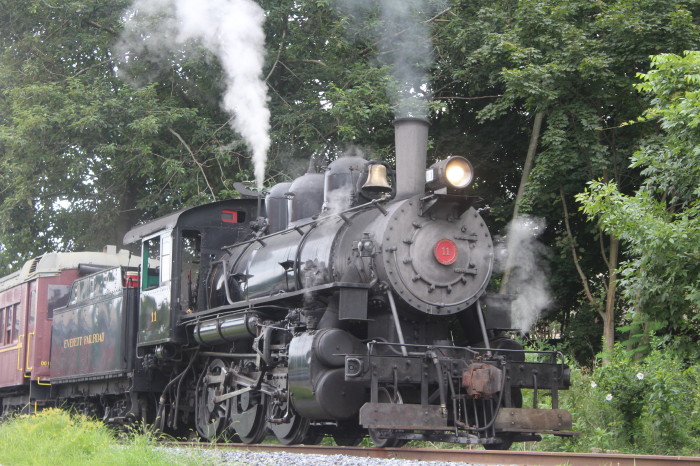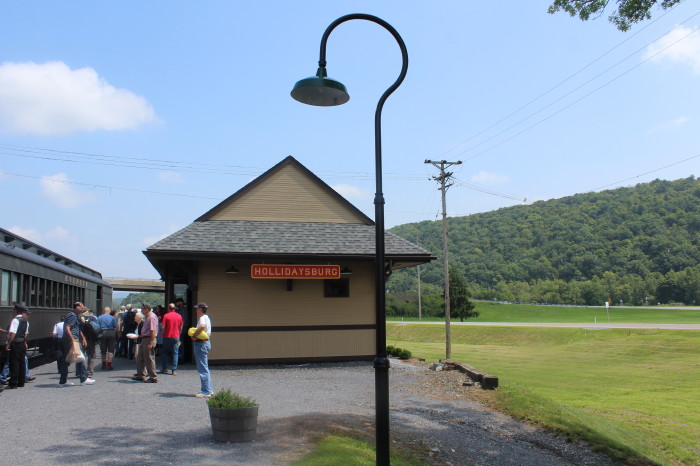Everett Railroad History
The Everett Railroad is a short-line railroad that operates
ex-Pennsylvania Railroad trackage in the Hollidaysburg area of
the U.S. state of Pennsylvania. It runs freight trains over
two separate lines, one from Brooks Mill and Sproul, and the
other, owned by the Morrison's Cove Railroad, from Roaring
Spring to Curryville and Martinsburg. The affiliated
Hollidaysburg and Roaring Spring Railroad, which the Everett
Railroad operates both under contract and via trackage rights,
connects the two segments to each other and to the Norfolk
Southern Railway in Hollidaysburg. The Everett Railroad name
refers to its former location near Everett, abandoned in 1982.
The Everett Railroad was incorporated in April 1954 to take
over a portion of the Huntingdon and Broad Top Mountain
Railroad and Coal Company near Everett, which was abandoned in
May. The line, which extended north from the end of the
Pennsylvania Railroad's Mt. Dallas Branch at Mount Dallas to a
point near Tatesville, parallel to PA Route 26, had been
constructed from 1859 to 1863 by the Bedford Railroad, which
was merged into the H&BT in 1864. Conrail discontinued
service on the then-Mt. Dallas Secondary in October 1982,
severing the Everett Railroad's ties to the outside world and
forcing its abandonment.
The company was revived in May 1984, when it acquired a part
of Conrail's Bedford Secondary between Brooks Mill and Sproul.
Completed in 1910 by the Bedford and Hollidaysburg Railroad, a
predecessor of the Pennsylvania Railroad, this line had
connected to the Mt. Dallas Secondary near Bedford until 1982.
A second line, the Morrison's Cove Secondary from Roaring
Spring to Curryville, along with a short branch into
Martinsburg, was acquired by the Morrison's Cove Railroad,
organized by local shippers, in mid-1982. The shippers
initially contracted with the Allegheny Southern Railway,
which operated the line from September 1982 to the end of
1984, but on January 1, 1985 the Everett Railroad took over
operations. This line had been constructed by the Pennsylvania
Railroad itself in 1871. Conrail continued to operate the
remainder of the Morrison's Cove Secondary, from Roaring
Spring through Brooks Mill to Hollidaysburg, until Alan W.
Maples, owner of the Everett Railroad, organized the
Hollidaysburg and Roaring Spring Railroad and bought the line
in March 1995. Simultaneously, the Everett Railroad acquired
trackage rights to Hollidaysburg, and began operating the
H&RS under contract.
Everett Railroad 2-6-0 11
Construction of number 11
Steam locomotive number 11 was constructed in 1920 by the
Cooke Works of the American Locomotive Company in Paterson,
New Jersey. It is a "2-6-0" or "Mogul" type and was one of 54
engines of four different wheel arrangements built between
1920 and 1925 intended for export to Cuba and use in that
country's sugar cane fields. Building locomotives for stock
was not common practice and fluctuations in world sugar
markets post World War I unexpectedly reduced demand for these
engines, leaving a number of them unsold on the factory floor.
Alco turned to the domestic short line railroad market but it
was not until 1923 that the tiny Narragansett Pier Railroad in
Peace Dale, Rhode Island, purchased the engine, assigned it
number "11", and put it to work on their eight and a half mile
railroad.
Revenue Service
Through its working career at both the NP Railroad and the
B&H Railroad, engine 11 was a living symbol of the great
American tradition of small independent railroads connecting
local communities with the national rail network. Weighing a
mere 55 1/2 tons, its modest proportions were typical of light
short line locomotives all across the country in the age of
steam power.
Preservation and Restoration
The Bath & Hammondsport Railroad retired number 11 in
1949 in favor of diesel power and the engine, an object of
some sentimental attachment, was carefully stored in the
railroad's enginehouse until sold in 1955 to Dr. Stanley A.
Groman for his "Rail City" museum in Sandy Pond, NY. Dr.
Groman was a pioneer railroad preservationist and for many
years the locomotive operated on his mile long circle of track
near the shore of Lake Ontario. But the eventual construction
of interstate highways siphoned visitors away and Rail City,
like many roadside attractions of the 1950s, withered and
eventually closed. Around 1977 engine 11 was sold to another
collector, Dr. John P. Miller who had earlier purchased the
Narragansett Pier Railroad. Thus it was that the locomotive
returned to the enginehouse at Peace Dale, Rhode Island. Some
disassembly and inspection work was done but Dr. Miller never
completed the overhaul and number 11 was sold again, in 1981,
to the Middletown & New Jersey Railroad of Middletown, NY.
Pierre Rasmussen, president of the M&NJ, was a fan of
steam engines and thought number 11 would be an ideal addition
to his short line. The locomotive was stored inside the
M&NJ enginehouse, protected from the weather, but no
further repairs were ever done. With sale of the railroad
pending following Pierre Rasmussen's death in 2004, ownership
of number 11 transferred to James Wright, a business partner
in the M&NJ. Wright, in turn, sold the engine to Alan
Maples, president of the Everett Railroad, in 2006.
# 11 getting ready to move to the next track to hook up to the
passenger cars which consisted of Everett Railroad 2-6-0 11,
combine 23, coaches 103, 105 and 104. All coaches are former
Erie-Lackawanna.
The station was built in 2015 to resemble a typical Pennsylvania
Railroad depot of the area. The station features a ticket counter
and gift shop, waiting room and restroom facilities.

MP 8.7. Heading east from the train station are the
last of the many railroad shops once located in Hollidaysburg.

This complex includes the
1955 Samuel Rae Car Shops, renamed the Hollidaysburg Car Shop
by Conrail. Tens of thousands of freight cars were built in
Hollidaysburg over the years. Parts of the complex are still
used for car repairs and scrapping. Bob Alkire was the winner
of the first cab ride aboard Everett 11 today and really
enjoyed his ride between Hollidaysburg and our first photo
spot, Kladder.

Map courtesy of Barton Jennings from his book "Everett
Railroad: History Through the Miles" part of his series;
History Through the Miles. I used his notes in this
report.

MP 12.2 Kladder - Just to
the east is the Saint Bernardine Monastery, operated by the
Franciscan Friars TOR (Third Order Regular). The history of
the monastery states that the "Monastery building was erected
and dedicated to St. Bernardine of Siena to honor ... it is
said ... the patron saint of the Minister General's delegate,
Fr. Bernardine Russo, who had proved a wise and friendly
advisor to the friars. It was a proud occasion for the friars
of the new Province when, in the summer of 1928, Bishop
McCort, in the presence of a large crowd of clergy and laity,
blessed and laid the cornerstone of the Monastery building.
The first class of candidates was accepted on October 17,
1929." The history of the monastery mentions the railroad
several times as a means of travel and a source for moving
supplies and goods produced on their farm.
Little is known about the name, except that
the family of Daniel Kladder once lived in this general area
and that there a Kladder Cemetery nearby.

Train getting ready for our runby after we detrained.


Photographers getting ready for our first runby.

We then went east toward Rodman where we detrained for another
runby.

MP 16.0 Rodman is located in McKee Gap and is named for the
old Rodman Furnace that once stood nearby. Our runby
site was in front of the Roaring Spring Quarry which has a
conveyor system that brings the rock in from the quarry.
Reports are that the rock is seldom shipped off the railroad
due to the many sources of rock in the area, but it makes
great ballast for the railroad.







MP 17.0 Appvion - The large Appvion paper mill is currently
the largest customer of the Everett Railroad. The railroad
delivers chemicals and plastics to the mill and ships out
coated paper.

MP 18.9 Smith
Transport provides various types of transportation
services, as well as warehousing services. This is a
recognized transload partner with the Everett Railroad,
providing temperature-controlled storage, racked space.
distribution services, 12 rail doors and 50 truck doors.

Pennsylvania countryside dotted with impressive farms.


MP 20.1 Peck.
Peck was the name of an important family in Duncansville,
near Hollidaysburg. Today, it is the location of the
Renaissance Nutrition feed-mill. "Ren Nut" is the common
name for the facility. The firm is a "full-service vitamin
and mineral premix company," making customized feed
primarily for the local dairy and livestock industry but
it also makes feed for swine, sheep, goat, equine and
poultry markets. The railroad serves this mill on a
regular basis, especially delivering citrus products to be
mixed with the feeds.



MP 21.1 Cargill feed mill.

The farm in back center is actually part of Cowan
Equipment, a used farming equipment dealership that
specializes in older and historic equipment.

MP 22.2 Martinsburg. Old high school on left.

New modern high school.

We came to Martinsburg junction which is a wye which will
allow the engine to be turned for the trip back to
Hollidaysburg. This is as far as our train went.

Up close and personal with # 11 all the way back to
Hollidaysburg. So now we will have a second chance to
see things along the route.


Mill at Cargill.

Altoona is a short drive from here.


Ren Nut in Peck.



Smith Transport.

Homes in Roaring Spring.

At Roaring Spring Station only the photographers were
allowed to detrain for the photo runby.

I walked across the street to get my photos.






After the runby, the rest of the passengers
detrained at the station platform for a box lunch.
As traveling makes you hungry, everyone queued up
for their lunch of choice as there was a variety of
main entrees and for dessert was the best ice cream
by a county mile.

After a quick thirty minutes the conductor said
let's go and with everyone back on board we left at
1:00pm for the last leg of this trip on the last
trip of 2018 NRHS Convention.

Quarry and site of a runby.

Cars in the rail yard at Hollidaysburg.

After
returning to our starting place, everyone headed
for the buses and the return to the hotel. I
would like to thank the NRHS for the convention
work here in Cumberland including John Goodman,
Chairman, Skip Waters, Dan Meyer and Dawn
Holmberg, Steve Siegrist, Steve Barry and Bob
and Elizabeth for their excellent service and
for making this convention a major success. A
big plus was the ability to take Amtrak to the
hotel's door. Absolutely no airplanes involved
in this trip or harmed. After returning to the
hotel, we waited in the hotel lobby, as we were
room-less, for our train this evening. It was
decided that the four of us would have a last
supper together before going our separate ways
tomorrow. The local eatery Crabby Pig was chosen
and we walked the couple of blocks to it. The
convention banquet is tonight and the others
refused to eat the great Amtrak airline-like
meals that were offered courtesy of the airline
taxi pilot in charge at headquarters.

On the way to the Crabby Pig we passed by the
Western Maryland Railroad Station. After a good
and merry diner we then walked backed to the hotel
and got our luggage out of baggage check. Then we
walked across the main line to the Amtrak station.

The CSX helper going back to the yard.



The Capitol Limited on approach to the Cumberland
Station.

The Capitol
Limited #29 came into the Cumberland station and
first stop was for the engineer change. The
conductor scanned everyone's tickets who were
waiting to board the train in Cumberland. The
second stop was for the first sleeper. We all
were on the third stop and we had roomette 4 and
the Alkires had Bedroom D. Our sleeping car
attendant was Leroy.
Being a curious guy and
usually open to try something new, I made my way
to the cafe car to partake in Amtrak's first
class dinner offering tonight. For tonight's
choice I chose the short ribs. I rarely see
short ribs on a menu, so when I do I like to try
them. Basically this new meal system is a first
cousin to the box lunches we have on
conventions. The cafe attendant removed the
dinner box from the refrigerator, separated the
hot items from the cold and placed them in the
oven to warm up. I was then presented with both
in the box with each item wrapped separated in
plastic. It was a festival of plastic with the
packaging, tableware and dishes. I think
civilization took a step backwards when we
stopped washing dishes and reusing them. One of
the unique experience of riding on a long
distance train trip is the community seating and
dining in the dining car. If you are a single
you never dine alone, they place four at a table
with possibility of four strangers dining
together and striking up interesting
conversations and with your food hot from the
kitchen. Tonight I was the sole diner in the
cafe car although I enjoyed the ribs and the
sides. Plus with the meal you get an alcohol
beverage included so I had a cocktail with
dinner. The attendant knew that there was two in
our room so he said I could have a drink to take
back for Chris. And as Chris doesn't partake, I
had a second drink, thanks Chris for the
cocktail.
Afterwards we all met in the
lounge car for the ride over Sand Patch and
beyond. Leroy had made up the room and I called
it quits after Connellsville and retired to our
roomette for a night on the rails. The morning
will find us traveling through the Midwest on
our way to Chicago.
Thanks for
reading.
Text and Photos
by Author
The author
retains all rights. No
reproductions are allowed
without the author's consent.

